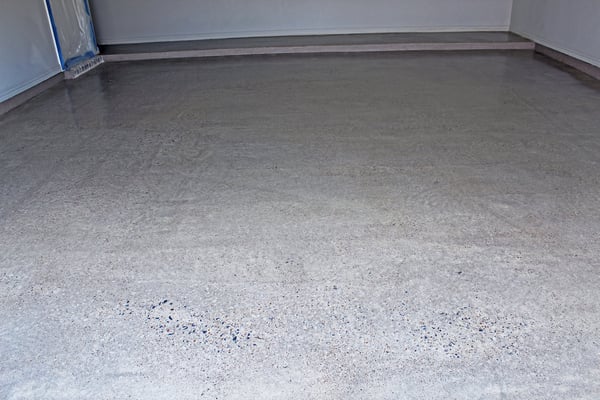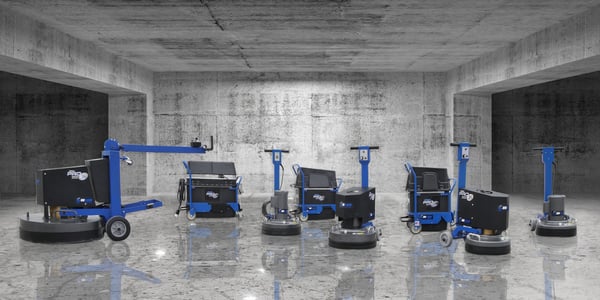Contractors know that their worth is only partially their work ethic, skills, and reliability. What makes the difference between a booming business and a struggling startup is the quality of your tools.
You may have thoroughly convinced your client that concrete floors are perfect for them, but now what?
To be profitable, you need tools you can trust to deliver a great finished product without wasting time and money. When it comes to refinishing concrete, you need the best concrete grinder to guarantee an efficient and successful job.
How do you know when you've found the one? In this brief guide, you'll learn 6 tips for finding the best concrete grinder for your business.


1. Size of the Floor
Every contractor has a niche, so you need to recognize what types of jobs make up most of your profits. Do you typically work in residential areas, or do businesses use you more often?
If you mainly work in residences, you are most likely doing many small jobs. On the other hand, if you do more contracted work for businesses, you are most likely completing larger projects.
The size of the floor you typically work on will affect your decision when choosing a concrete grinder. Some concrete floor grinders are better choices for precision jobs while others are made to cover larger surfaces quickly.
It's important to choose the right grinder according to the size of the floor and to use them with the correct techniques because you can cause unevenness on the concrete floor. Larger floors done with smaller concrete grinder blades can end up with low and high spots easily.
Some concrete floor grinders have several rotating discs while others have one main grinding blade. The most common types of grinders have one head, two heads, or planetary disc heads.
Typical grinding discs are 8-12 inches in diameter. Planetary disc grinders have several smaller discs all connected to one main disc. For larger floors, depending on a planetary disc grinder means delivering powerful and evenly-applied grinding.
2. Extent of the Job
Do you have several small floors to finish or one very large room? How many hours or days will this project take, and will it require a lot of labor?
The size of the floor is not the only factor for what type of grinder you need. Concrete floor grinders are meant to make your job easier, so choose one that's specially made for your circumstances.
In general, there are three categories of concrete grinders: handheld, walk-behind, or ride-on.
Handheld Concrete Grinders
Handheld concrete grinders are easily portable, compact, and great for small spaces. Measuring either 4-5 or 7-9 inches, handheld grinders make cramped rooms like bathrooms and closets a breeze.
The downside of handheld grinders is that they pack less of a punch. They're still powerful, but they won't quickly and easily grind down large areas like other grinders. You'll also have to be down on your knees manually moving the grinder around and making sure you've sanded the floor evenly.
Keep a handheld concrete grinder handy for finishing up corners and tough spots, but don't use them for the majority of the work. They are best used for coating removals and surface cleanings.
Walk-behind Concrete Grinders
Walk-behind grinders are the moderate choice for most projects. Instead of being on your hands and knees, you can do your job standing up. You'll also get a greater area of the floor done faster because this category of grinders typically come between 16-48 inches in diameter.
Walk-behind grinders also have more power behind them and can run on gas so that you don't need to worry about cords. Contractors should strongly consider investing in at least one walk-behind, as they come in handy if you handle large concrete slabs.
While walk-behind concrete grinders are a better choice than handheld grinders, they'll still make your job harder if you have a very large or difficult project. Keep one on hand for handling outdoor residential spaces like around sheds and swimming pools.
Ride-on Concrete Grinders
Ride-on concrete grinders are impressive machines because they can finish up to 5 feet at a time. These grinders can be powered by gas, electricity, or propane, and they are so powerful that they reveal glossy new floors in one pass.
If you're staring down the barrel of a concrete floor with difficult coatings or residues, a ride-on concrete grinder won't blink an eye.
There's no question that contractors need a ride-on concrete floor grinder for major projects. If you ever work in warehouses or shopping malls, these grinders are your best bet. It'll save you time and be much easier on your body, and all of that equals more profits for you.

3. Grit and Bond Needed
Do you need to remove mastic or some other tough material, or is this a simple polishing job? Concrete grinding discs come with different levels of grit according to the type of job.
Higher number labels on grits mean that the disc is less aggressive to the concrete surface. These grit levels are best for polishing after the hard work has been done. A typical label for a concrete grinding wheel meant to polish is 80 or 100.
More aggressive grits are meant to remove coatings like epoxy and mastic or grind down harder concrete. For tough jobs, you can try an 18 or 20 grit. For moderate jobs, you can resort to a 30 or 40 grit.
Grit isn't the only thing to pay attention to. The hardness of concrete can wear down your tools if you're not using the right kind.
Newer concrete tends to be harder while older concrete tends to be softer. If you're dealing with newer concrete, you'll want to make sure your tool is equipped with the right bond.
The bond is the level of wear resistance. You'll want a soft bond for harder concrete floors so that new diamonds are released quickly to keep grinding down the concrete. For softer concrete, you'll want a hard bond

4. Preference for Controlling Dust
If you're grinding down concrete, you're creating a lot of dust. It's impossible to work in conditions where dust is everywhere, so you'll need to control it somehow. Concrete grinders come with options for wet and dry grinding.
Using a wet grinding technique makes sure dust won't go anywhere. Instead, dust will turn into mud on the floor that can be cleaned up as you go.
If you're looking to do wet grinding, you'll need to find a grinder that has a water hookup. The machine will release water as it grinds if you have a hose connected.
The other way to control dust is dry grinding while vacuuming. Many machines have vacuuming capabilities that will pick up dust as they grind.
Most contractors choose to use dry grinding, as it is less messy. However, wet grinding is a great option for outdoor projects.
Regardless of your choice, make sure to buy the appropriate discs for the dust control. You should get wet grinding discs for projects with water and dry grinding disc for projects using vacuums.

5. Weighing the Cost
It's true, commercial-grade tools can be expensive, but they're a necessary investment. If you want your business to thrive, you'll need to balance cost with reward.
Handheld concrete grinders are much more affordable, and they're often marketed to DIY-ers looking to complete their own small projects. The affordability might be tempting, and you should have some of your own, but relying on these grinders for all your projects is a mistake.
You might save money now, but you'll be wasting time on projects and not delivering acceptable quality in your results.
Walk-behind concrete floor grinders are arguably the most important tool in your chest. They are moderately priced and worth the investment for most projects. You can also sometimes connect a few walk-behind grinders to cover more floor space, achieving a similar effect to a ride-on grinder.
Expect to pay around $5,000-9,000 per walk-behind grinder.
A ride-on grinder will be a serious investment, but if you plan on tackling massive projects, you'll need these to survive. Several walk-behind concrete grinders will only get you so far, so you need to calculate risk and reward.

6. The Best Concrete Grinder Performance
If you already have a few tools and have been doing jobs for a while, you're starting to notice which tools last longer and are more effective. Use this information when you're looking to refine your process.
A great way to determine which tools you should keep using and which ones you should ditch is to monitor their performance over time. You can use a simple equation to figure out if a tool is working for you:
Calculate how much square footage you have completed with a certain tool, and write down how long it took you to complete that area. Divide the area by the total grinding time to get a numerical value for performance. This number represents the total number of square feet that you complete per hour with this tool.
Compare this number to your other tools over several projects to see how well they perform for you. You may have hard evidence that you're better off using more ride-on grinders, or that you're doing just fine with walk-behind grinders.
Improve Your Business Now
Becoming successful doesn't happen overnight, but it sure doesn't happen without educating yourself to make the right decisions for your projects. You've taken a great step towards refining your process, so now it's time to make the best concrete grinder purchase.
Onfloor technology keeps the best tools in stock for your concrete grinding needs. Start shopping today!

0 comments